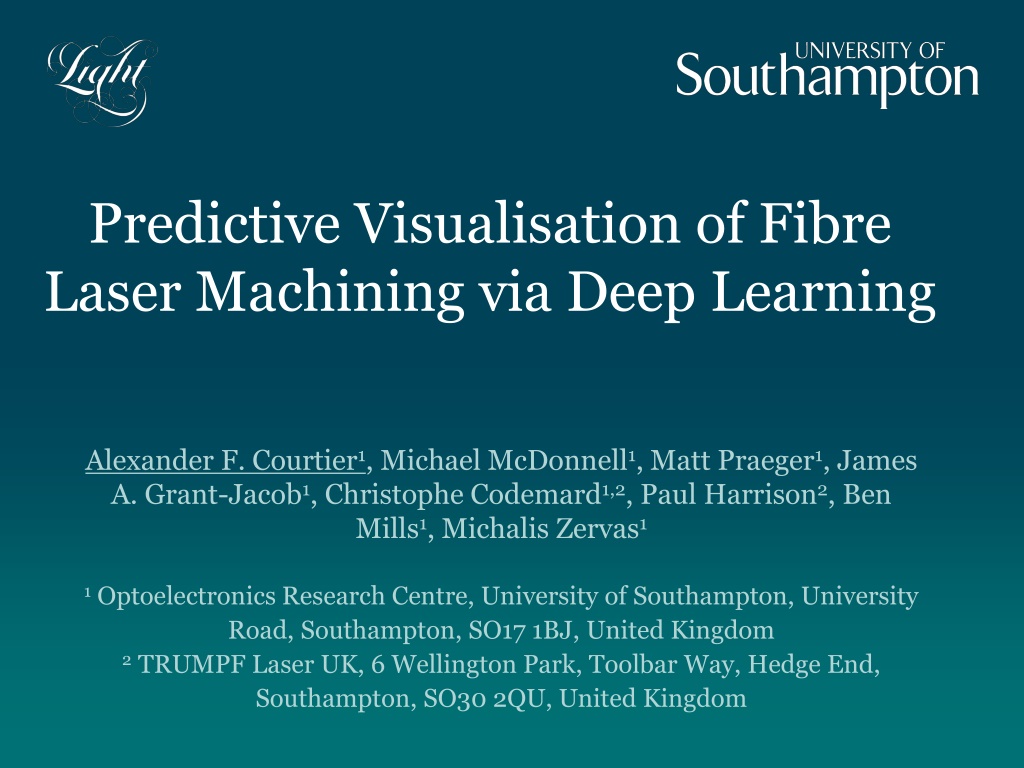Predictive Visualisation of Fibre Laser Machining via Deep Learning
Laser cutting is a fast and precise method, but predicting defects can be challenging. This study explores using Deep Learning to model and forecast laser cutting defects based on parameters. Topics include introduction to laser cutting, deep learning, imaging, and conclusions.
Download Presentation

Please find below an Image/Link to download the presentation.
The content on the website is provided AS IS for your information and personal use only. It may not be sold, licensed, or shared on other websites without obtaining consent from the author. Download presentation by click this link. If you encounter any issues during the download, it is possible that the publisher has removed the file from their server.
E N D
Presentation Transcript
Predictive Visualisation of Fibre Laser Machining via Deep Learning Alexander F. Courtier1, Michael McDonnell1, Matt Praeger1, James A. Grant-Jacob1, Christophe Codemard1,2, Paul Harrison2, Ben Mills1, Michalis Zervas1 1 Optoelectronics Research Centre, University of Southampton, University Road, Southampton, SO17 1BJ, United Kingdom 2 TRUMPF Laser UK, 6 Wellington Park, Toolbar Way, Hedge End, Southampton, SO30 2QU, United Kingdom
Outline Motivation Introduction to laser cutting Introduction to deep learning Imaging of laser cutting Using deep learning to model laser cutting defects Conclusions 2
Motivation Laser cutting enables fast, precise, contact-free cutting of materials. However, modelling of light-matter interactions can be challenging. Can Deep Learning model and predict laser cutting defects based on laser parameters? 3
Fibre Laser Cutting Continuous wave laser cutting is achieved by irradiating and locally melting the workpiece, and removing the molten material with an assist gas. Fast, precise, and contact-free. However, defects can be formed at the edge of the cut, negatively impacting cut quality. 4
Deep Learning Deep Learning is a subset of machine learning using deep Neural Networks (NNs). NNs can act as universal function approximators, and therefore can be used to model any complex system. Used for tasks such as classification, regression, and image generation. 5
Deep Learning Deep Learning is a subset of machine learning using deep Neural Networks (NNs). NNs can act as universal function approximators, and therefore can be used to model any complex system. Used for tasks such as classification, regression, and image generation. 6
Convolutional Neural Networks Extracts features from datasets using convolutional filters Can be used to transform images into a numerical label Highly suitable for image analysis 7
Generative Adversarial Networks (GAN) Formed of a generator network and a discriminator network working in opposition The generator predicts an output, if a labelled input is used they are called Conditional GANs (CGANs) The discriminator determines if an output is experimental or predicted 8
Imaging of Laser Cutting 2mm thick stainless steel sheets were cut by fibre laser a 2kW, 1075nm at ten cutting speeds, 15 m/min to 24 m/min. Imaged after machining using 5x optical microscope Experimental image of laser cut edge
Experimental A) 15 m/min B) 16 m/min C) 17 m/min D) 18 m/min E) 19 m/min F) 20 m/min G) 21 m/min H) 22 m/min I) 23 m/min J) 24 m/min
Identification of Laser Cutting Speed A CNN identifies the cutting speed using images of the laser cut. 99.9% accuracy. Trained for 10 epochs on ~90000 images and tested on ~10000 images. Demonstrates that each cutting speed produces unique defects. 11 11
Parameter to Image Visualisation Successfully reproduces defects from parameters Speed shown: 15 m/min Reproduces angle of striations (22.5 2.2 experimentally, and 26.8 2.2 predicted) 12 12
Parameter to Image Visualisation Successfully reproduces defects from parameters Speed shown: 15 m/min Reproduces angle of striations (22.5 2.2 experimentally, and 26.8 2.2 predicted) Predicted Experimental 13 13
Parameter to Image Visualisation Successfully reproduces defects from parameters Speed shown: 20 m/min Reproduces angle of striations (32.7 3.0 experimentally, and 36.9 3.6 predicted) 14 14
Parameter to Image Visualisation Successfully reproduces defects from parameters Speed shown: 20 m/min Reproduces angle of striations (32.7 3.0 experimentally, and 36.9 3.6 predicted) Experimental Predicted 15 15
Adjacent Image Visualisation Successfully predicts defects from adjacent images Can use a predicted image as an input Can be chained to predict subsequent predicted images Speed shown: 15 m/min 16 16
Adjacent Image Visualisation Successfully predicts defects from adjacent images Can use a predicted image as an input Can be chained to predict subsequent predicted images Speed shown: 15 m/min Experimental Predicted 17 17
Adjacent Image Visualisation Successfully predicts defects from adjacent images Can use a predicted image as an input Can be chained to predict subsequent predicted images Speed shown: 20 m/min 18 18
Adjacent Image Visualisation Successfully predicts defects from adjacent images Can use a predicted image as an input Can be chained to predict subsequent predicted images Speed shown: 20 m/min Experimental Predicted 19 19
Conclusions CNNs can distinguish laser cutting defects by cutting speed with 99.9% accuracy. CGANs can accurately visualise laser cutting defects from laser cutting parameters and adjacent images. May have applications in real-time monitoring and real- time predictions of laser cutting defects, to optimise the laser cutting process. This work was supported under EPSRC (grant numbers EP/N03368X/1 and EP/N509747/1)

 undefined
undefined

























